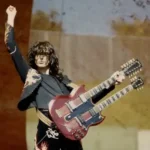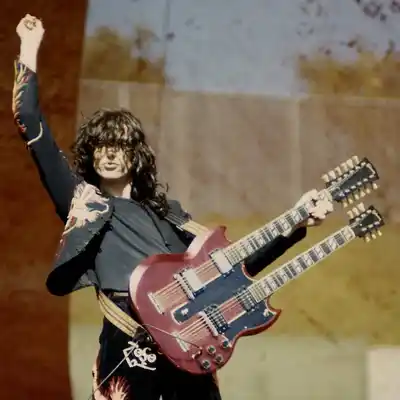
Jimmy Page and His Iconic Guitars
Jimmy Page is undeniably one of the most influential and revered guitarists in the history of rock music. As the founder and lead guitarist of the legendary band Led Zeppelin, Page’s unique style and innovative techniques have left an indelible mark on the world of music.
In this post, we’ll explore the incredible life and career of Jimmy Page, his iconic guitars, and the equipment that helped shape his sound.
Table of Contents
Biography
Born James Patrick Page on January 9, 1944, in Heston, Middlesex, England.
When Jimmy was eight years old, Page’s family moved to Epsom, Surrey, where his father got a job as a human resources manager. Until the age of 12, he had a normal childhood like almost every child. But then something happened that changed his life forever. On the radio he heard Elvis Presley singing “Baby, Let’s Play House.” With his pocket money and a bonus from his mother, he bought a second-hand Spanish guitar and, after a few lessons, learned to play quite well. His parents encouraged his passion for music.
Jimmy was 15 years old when Neil Christian was also present at a dance party at a local community center where he had already performed occasionally. Neil had his own band, The Crusaders. Neil asked him if he wanted to come play in his band. After his parents’ approval, Jimmy toured with the band for two years, but a glandular condition forced him to leave. Jimmy went to study contemporary art at Sutton College.
He was still more concerned with the music and often went to jam sessions where he met Jeff Beck regularly. Jimmy had already played in several bands such as The Cyril Davies All Stars, Carter Lewis, and the Southerners, becoming one of the most popular session musicians in London. He played with artists such as Burt Bacharach, PJ Proby, The Who, The Kinks, Herman’s Hermits, Donovan, Brenda Lee, and Lulu.
In 1965, Jimmy began recording his first single, “She Just Satisfies,” with “Moving on” as the B-side. During this time, Jimmy also regularly met with Eric Clapton to record some tracks. Jimmy was very tired of all this session work and decided to play with The Yardbirds, taking Paul Samwell-Smith’s place as bassist. But soon the roles in the group were distributed differently, Chris Drey exchanged bass guitar with Jimmy, but this transformation was short-lived.
At the end of 1966, Jeff Beck disbanded the group because the others were not cooperating with him. The Yardbirds were not well received and the group broke up in early 1968. To fulfill existing contracts, Jimmy had to quickly form another group. Terry Reed was his first choice as lead singer, but Terry was still under contract. Terry introduced him to Robert Plant, who was studying to become a teacher and played in a school band called Hobbstweedle.
Robert accepted the idea and already had drummer John Boehm in mind. John Paul Jones was appointed bassist and Jimmy accepted. After three weeks of intensive rehearsals, the group was ready to work on outstanding contracts in Sweden. Since 1969 the name has changed to Led Zeppelin. Their first album, Led Zeppelin, was released that same year. Subsequent albums Led Zeppelin II, III and IV went platinum. In 1975, they were the most successful group to date. Subsequent albums reach platinum status.
On September 25, 1980, drummer John “Bonzo” Bonham was found dead in his bed. He suffocated on his own vomit after drinking all day. The remaining members decided that they did not want to continue without Bonham. In December 1980, Led Zeppelin officially disbanded.
Jimmy Page’s Guitars
- 1959 Fender Telecaster: Jimmy Page’s first notable guitar was a 1959 Fender Telecaster, which he acquired in 1964. This guitar played a crucial role in Page’s early career, both as a session musician and during his time with The Yardbirds. He later adorned the Telecaster with mirrors and hand-painted psychedelic designs, dubbing it the “Dragon Telecaster.” Page used this guitar to record Led Zeppelin’s eponymous debut album and played it during many live performances.
- 1958 Gibson Les Paul Standard “Number One”: Arguably Jimmy Page’s most iconic guitar, the 1958 Gibson Les Paul Standard, nicknamed “Number One,” was purchased from Joe Walsh in 1969. This sunburst Les Paul became synonymous with Page’s sound during his time with Led Zeppelin. He used it extensively, both in the studio and live, for classics such as “Whole Lotta Love” and “Stairway to Heaven.”
- 1959 Gibson Les Paul Standard “Number Two”: In 1973, Page acquired his second sunburst Les Paul, a 1959 model, which he called “Number Two.” This guitar featured a push-pull system that allowed Page to achieve various pickup configurations, giving him a wide range of tonal options. He often used this guitar as a backup for “Number One.”
- Gibson EDS-1275 Double Neck: The Gibson EDS-1275 Double Neck is another iconic instrument associated with Jimmy Page. The 6 and 12-string combination allowed him to perform songs like “Stairway to Heaven” and “The Song Remains the Same” live without switching guitars. Page’s use of the EDS-1275 helped popularize the double-neck guitar among rock musicians. The Serial Number is 911117.
- Fender Stratocaster (Lake Placid Blue) 1960 – is a classic example of Fender’s craftsmanship from the early ’60s.
- Gibson RD Artist – is somewhat of an outlier in Gibson’s lineup, known for its unique body shape and advanced electronics for the time it was released in the late 1970s.
- Fender Stratocaster 1966 – Stratocasters from this period are prized for their playability and the rich, dynamic tone they produce.
- Fender 10-String 800 Pedal Steel: Be heard on the albums Led Zeppelin and Led Zeppelin III.
- Gibson J-200 (acoustic): Uses include the album Led Zeppelin I.
- Harmony Sovereign (acoustic): Be heard on the album Led Zeppelin III and during the tour of 1970.
Jimmy’s Guitar Equipment
Amplifiers
Throughout his career, Jimmy Page has been closely associated with Marshall amplifiers, particularly the Marshall 1959SLP 100 with a two-channel preamp and 100-watt amp output. In combination with a cabinet 412 one of the most popular and used in the ’60s, ’70s, and ’80s. He often used multiple Marshall stacks to achieve his signature, powerful sound. Additionally, Page occasionally utilized Vox, Orange, and Hiwatt amplifiers.
Effects Pedals
Page’s choice of effects pedals played a significant role in shaping his sound. Some of his most commonly used pedals include:
- Vox Cry Baby Wah-Wah: A key component of Page’s sound, this pedal helped him create the distinctive tones on tracks like “Dazed and Confused” and “Whole Lotta Love.”
- Maestro Echoplex: This tape-based delay unit was a crucial part of Page’s sonic arsenal. The Echoplex allowed him to create complex, layered textures, as heard on songs like “Achilles Last Stand” and “Kashmir.”
- Sola Sound Tone Bender: As one of the pioneers of fuzz guitar tones, Page often employed the Sola Sound Tone Bender fuzz pedal to achieve a thick, distorted sound. This can be heard prominently on tracks like “Heartbreaker” and “Communication Breakdown.”
- MXR Phase 90: A popular phaser pedal, the MXR Phase 90 was used by Page to create swirling, psychedelic tones on songs such as “No Quarter.”
- Boss CE-2 Chorus: Although not used extensively, the Boss CE-2 Chorus pedal can be heard on some of Led Zeppelin’s later recordings, adding a lush, shimmering texture to Page’s guitar sound.
- Roland Space Echo: This tape-based echo unit was another favorite of Page’s. The Roland Space Echo was used on several Led Zeppelin tracks, including the iconic intro to “When the Levee Breaks.”
- Theremin: Jimmy also made use of a Theremin. A device that falls more under a synthesizer than a guitar effects unit. A description of this instrument can be found at Effect Equipment on this site. In the songs “Whole Lotta Love” and “No Quarter” is good to hear this instrument.
Jimmy Page’s legacy as a guitarist and producer is unparalleled. His unique approach to the guitar has left a lasting impact on rock music. Page’s contributions to the world of music are still felt today, inspiring countless musicians to follow in his footsteps.
